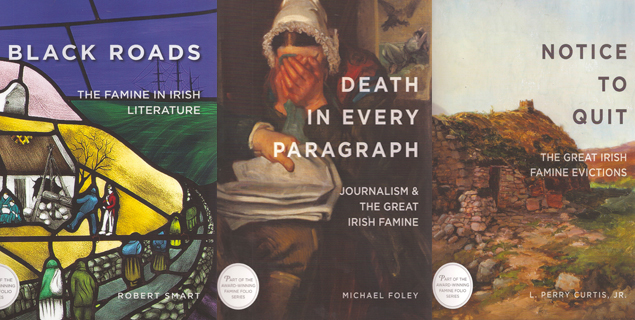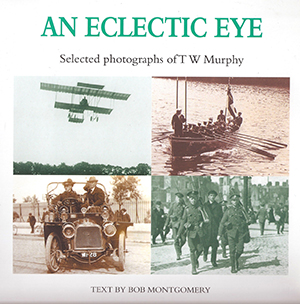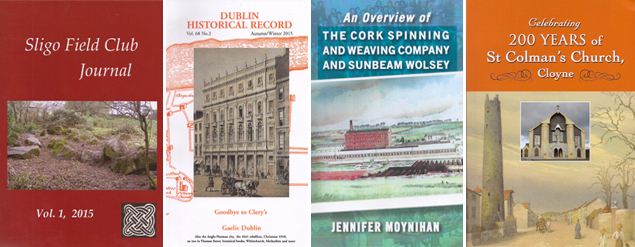BOOKWORM
Published in Book Reviews, Issue 3 (May/June 2016), Reviews, Volume 24John Gibney, A history of the Easter Rising in 50 objects (Mercier Press, €19.99 hb, 224pp, ISBN 9781781173817).
Pádraig Óg Ó Ruairc, Truce: murder, myth and the last days of the Irish war of independence (Mercier Press, €19.99 pb, 384pp, ISBN 9781781173855).
Niamh O’Sullivan, In the lion’s den: Daniel Macdonald, Ireland and empire (Cork University Press, €29 pb, 152pp, ISBN 9780990468684).
Famine Folio Series, Quinnipiac University Press: Robert Smart, Black roads: the Famine in Irish literature, ($15, 44pp, ISBN 9780990468646).
Michael Foley, Death in every paragraph: journalism and the Great Irish Famine ($15, 46pp, ISBN 9780990468653).
L. Perry Curtis Jnr, Notice to quit: the Great Irish Famine evictions ($15, 44pp, ISBN 9780990468660).
Bob Montgomery, An eclectic eye: selected photographs of T.W. Murphy (Dreoilín, €25 pb, 128pp, ISBN 9781902773308).
Sligo Field Club Journal, Vol. 1 (Sligo Field Club, €20 pb, 154pp, ISSN 20098502).
Dublin Historical Record, Autumn/Winter 2015 (Old Dublin Society, €12 pb, 270pp, ISSN 00126861).
Jennifer Moynihan, An overview of the Cork Spinning and Weaving Company and Sunbeam Wolsey (Selfpublishbooks.ie, price not given pb, 120pp, ISBN 9781911180005).
Margaret Hartnett, Patricia Lyons and Kevin Terry, Celebrating 200 years of St Coleman’s Church, Cloyne (Cloyne Parish, 340pp, ISBN 9780993472817).

Several years ago the Irish Times had the novel idea of telling the history of Ireland in 100 objects. The series, edited by Fintan O’Toole, proved an outstanding exercise, as the examination of apparently simple, inanimate pieces allowed, paradoxically, for a more complex telling of the story to emerge. Now John Gibney—regularly of this parish—has taken the same approach to the current centenary in his equally impressive A history of the Easter Rising in 50 objects. A handsome, lightweight hardback from Mercier, 50 objects takes a simple chronological approach to its subject. Gibney begins with the 1905 certificate of US naturalisation of Tom Clarke, which allows the author to briefly review the reawakening of republicanism, and he closes with the Sigerson Monument in Glasnevin Cemetery (the story of which I’m embarrassed to say had escaped me), which cleverly anchors a discussion of the contested legacies of the Rising. In between, the events are chronicled in simple, clear prose which nevertheless manages to touch on many of the nuances of a complicated tale. The objects include the familiar (the by-now-famous ‘cricket bat that died for Ireland’ in Elvery’s window), the uncommon and the unexpected. In the ‘unexpected’ category we find a handkerchief embroidered with ‘Apr 30 1916 During the siege of Marrowbone Lane’, melted debris from the GPO and biscuits given to Kathleen Lynn while in prison. 50 objects serves as an excellent general survey of the Rising, and will appeal both to the novice and to those familiar with the subject.
The truce that ended the War of Independence was agreed at 8pm on Friday 8 July 1921, and formally came into force at noon on Monday 11 July. Almost from the start, official reports, historians and modern commentators have accepted/peddled the line that over that weekend the IRA went on a murder spree driven by vendetta and sectarianism, slaughtering innocents and Protestants, hitting ‘soft targets’ and settling scores with a violence for which they knew they wouldn’t be held to account. In contrast, the forces of the Crown were said to have immediately and compliantly retreated to barracks. Now, in Truce: murder, myth and the last days of the Irish war of independence, Pádraig Óg Ó Ruairc presents a—it has to be said—forensic and exhaustive examination of the violent events of that weekend that tells a different story. Indeed, readers of our last issue got a taste of Ó Ruairc’s work as he gave a synopsis of the controversial Ellis Quarry killings in Cork, hours before the truce came into effect. Rather than a sordid tale of four unarmed teenage British soldiers on their way to a sweetshop kidnapped and executed in cold blood, Ó Ruairc argues convincingly that the killings were in retaliation for the summary assassination, by veterans of the Western Front, of a twenty-year-old IRA member the previous night. Ó Ruairc opens with a close review of the behind-the-scenes efforts to negotiate a truce, which had begun as early as the autumn of 1920. Indeed, the fact that rumours of a truce had frequently arisen only to be dashed meant that when it did finally arrive many of the combatants initially refused to accept it. That attitude, along with the fact that it took IRA commanders some time to spread the word, particularly to the south-west, can in part explain some of the violence that took place. (Along the way, we learn of the extraordinarily high rate of suicide among RIC men in 1920.) The book examines in detail almost 60 killings, with meticulous research and the sources identified. Included are IRA executions of ‘spies’, killings carried out by Crown forces and Belfast’s Bloody Sunday, when the Truce’s proximity to ‘the Twelfth’ played a significant part. The popular, local republican legend is debunked. As ever, the Bureau of Military History witness statements are crucial. Despite common estimates of up to a dozen ‘spies’ being executed by the IRA, Ó Ruairc finds that he can document only six. (Remarkably, the IRA in Tipperary actually baptised one alleged informer themselves, without a priest, before executing him.) He also shows that many of the ‘disappeared’ assumed executed went on to live full lives. Many prominent figures are taken to task for their work on the subject, including such eminent historians as Charles Townshend and Eunan O’Halpin. One man who will find this particularly uncomfortable reading is columnist Kevin Myers. Of course, some of Ó Ruairc’s assumptions and conclusions will remain contentious. Nevertheless, this is an important book, which historians and members of the commentariat will have to come to terms with. Highly readable, Truce—another Mercier production—is certain to stand as the reference source as we run up to the centenary of the Treaty.

Niamh O’Sullivan and Cork University Press have produced an outstanding study of a badly overlooked nineteenth-century painter from Cork, Daniel Macdonald, In the lion’s den. Apart from his painterly flair, Macdonald—who was only 32 when he died in 1852—was also important for the subjects he chose to tackle, in particular the Famine. To place his work in context, O’Sullivan almost casually provides a fascinating cultural history of Cork in the first half of that century.

And, because it’s Cork, it’s often funny. And it is a gorgeous production, similar to the highest-quality art auctioneer’s brochure. A ‘must-have’ for anyone interested in Irish art and history, or who has a nice coffee-table.
O’Sullivan is also curator of Ireland’s Great Hunger Museum at Quinnipiac University in Connecticut, and that institution has produced an exceedingly handsome series of folios on the subject. Short, sharp, slim and smart, they are also beautifully illustrated, and they do exactly what they say on the tin. Michael Foley looks at the journalism of the time, L. Perry Curtis assesses evictions, while Robert Smart examines the Famine in literature.
In brief
An eclectic eye: selected photographs of T.W. Murphy. Murphy was a pivotal figure in recording cycling and motorcycling in the early twentieth century. This evocative collection also touches on wider events, such as the 1911 royal visit, the 1916 Rising (some of the most well-known images) and early aviation.
Sligo Field Club Journal. This first volume from the club includes articles on subjects ranging from a passage tomb in Skreen, to the Armada, to Sligo soldiers in the Connaught Rangers mutiny in India in 1920.
Dublin Historical Record. Essay topics include the 1641 rebellion in Balbriggan, Methodism in the 1920s and ’30s, the bilingual world of eighteenth-century Dublin, and Gaelic merchants in the city from the Restoration.
Sunbeam Wolsey. Jennifer Moynihan focuses on the commercial history of one of Cork’s famous employers. A pity there is not more social history included.
200 years of St Colman’s, Cloyne. Nicely produced. Focuses largely on the clergy, but Christy Ring gets a look in.

















